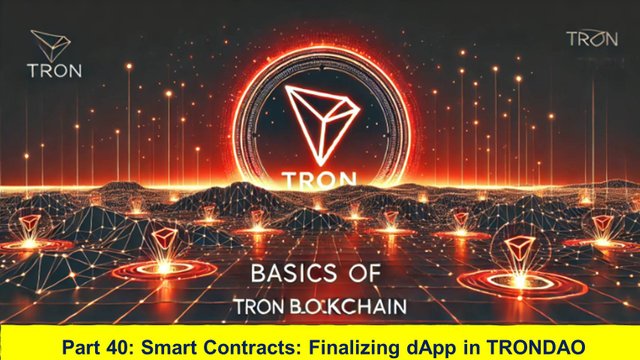Basics of Tron (Part 40) : Finzalizing Smart Contracts of dApp in TronDAO
Intro
IntroThe Tron Fan Club community works with people who love Tron Blockchain and are interested in blockchain technology. As a moderator of the community, I am regularly sharing the details of Tron with you. Our knowledge on any subject is enough. So, it’s a knowledge sharing opportunity for all of us. This community is an initiative to share tron based knowledge with each other.
Those who know a lot about the Tron blockchain have certainly come a long way, but for those who are brand new or want to get an idea on it from the beginning is a challenge. I am constantly writing in this community about the basics of Tron, from the very beginning. The name of this series I write about Tron is Basics of Tron. I provide links of my previous posts so that you can get a better idea by visiting those as well. Hopefully, tron lovers will be benefited from this series.


Up to last Post we have got ideas about design, interface of smart contracts related to decentralized application. After developing your decentralized application (dApp) on TronDAO, it’s time to prepare for launch. In this final post, I shall share to finalize the rest of the things and deploy your dApp to the public. I try to share the security issues of it as well.
Before launching DApp some crucial things must be done.
1. Testing:
Rigorously test your dApp. Becuase you can mind bugs and there may be performance issues. Utilize testing frameworks like Mocha or Chai for automated testing. This will help you quick checking of bugs.
2. Security Audits:
Consider conducting a security audit of your smart contracts. This process helps identify vulnerabilities and enhances user trust.
3. User Feedback:
Share your dApp with a small group of users to gather feedback on usability and features.
Deployment Options You can host your dApp in several ways:
1. Traditional Hosting:
Use web hosting services like AWS, DigitalOcean, or GitHub Pages. This approach is straightforward for static files.
2. Decentralized Hosting:
Consider hosting on decentralized platforms like IPFS (InterPlanetary File System) to align with the ethos of decentralization. DTube is working nicely in this system.
Deploying Your dApp If you choose traditional hosting, simply upload your project files (HTML, CSS, JS) to your hosting provider. If using IPFS, follow these steps:
- Install IPFS: Download and install the IPFS command line tool from the IPFS website.
- Add Files to IPFS: Use the following command to add your dApp files:
ipfs add -r /path/to/your/dapp - Retrieve the IPFS Hash: After adding files, IPFS will return a hash. This hash can be used to access your dApp on the IPFS network.
Marketing Your dApp Once your dApp is live, it’s essential to promote it:
- Social Media: Utilize platforms like Twitter, Reddit, and LinkedIn to share your dApp.
- Blockchain Forums: Engage with communities on platforms like Discord or Telegram to create buzz.
- Content Creation: Write blogs or create videos showcasing your dApp’s features and benefits.
Post-Launch Maintenance After launching, ongoing maintenance is crucial:
- Monitor Performance: Use analytics tools to track user engagement and performance metrics.
- Updates: Regularly update your dApp based on user feedback and technological advancements.
- Community Engagement: Foster a community around your dApp to encourage user retention and growth.
In this series of tutorials, we’ve covered the essentials of building a decentralized application on TronDAO, from initial setup to deployment. By following these steps, you can create a functional, user-friendly dApp ready for the blockchain space.
Best of luck for all those who are interested to create Decentralized application here. Thanks for stopping by.



Click to Join our Discord Server
Upvoted! Thank you for supporting witness @jswit.